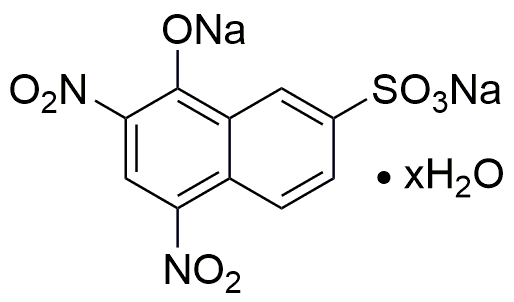Naphthol yellow S hydrate is widely utilized in research focused on various applications:
- Dyes and Pigments: Commonly used in the textile industry, it provides vibrant yellow coloring for fabrics, ensuring high visibility and aesthetic appeal.
- Food Industry: Employed as a food coloring agent, it enhances the visual appeal of products, making them more attractive to consumers while adhering to safety regulations.
- Biological Staining: In laboratory settings, it serves as a staining agent for microscopy, helping researchers visualize cellular structures and processes more clearly.
- Analytical Chemistry: Utilized in various assays and tests, it aids in the detection and quantification of substances, providing reliable results for quality control in manufacturing.
- Environmental Monitoring: Applied in the assessment of water quality, it helps in detecting pollutants, contributing to environmental protection efforts.
General Information
Properties
Safety and Regulations
Applications
Naphthol yellow S hydrate is widely utilized in research focused on various applications:
- Dyes and Pigments: Commonly used in the textile industry, it provides vibrant yellow coloring for fabrics, ensuring high visibility and aesthetic appeal.
- Food Industry: Employed as a food coloring agent, it enhances the visual appeal of products, making them more attractive to consumers while adhering to safety regulations.
- Biological Staining: In laboratory settings, it serves as a staining agent for microscopy, helping researchers visualize cellular structures and processes more clearly.
- Analytical Chemistry: Utilized in various assays and tests, it aids in the detection and quantification of substances, providing reliable results for quality control in manufacturing.
- Environmental Monitoring: Applied in the assessment of water quality, it helps in detecting pollutants, contributing to environmental protection efforts.
Documents
Safety Data Sheets (SDS)
The SDS provides comprehensive safety information on handling, storage, and disposal of the product.
Product Specification (PS)
The PS provides a comprehensive breakdown of the product’s properties, including chemical composition, physical state, purity, and storage requirements. It also details acceptable quality ranges and the product's intended applications.
Certificates of Analysis (COA)
Search for Certificates of Analysis (COA) by entering the products Lot Number. Lot and Batch Numbers can be found on a product’s label following the words ‘Lot’ or ‘Batch’.
Numéro de catalogue
Numéro de lot/série
Certificates Of Origin (COO)
This COO confirms the country where the product was manufactured, and also details the materials and components used in it and whether it is derived from natural, synthetic, or other specific sources. This certificate may be required for customs, trade, and regulatory compliance.
Numéro de catalogue
Numéro de lot/série
Safety Data Sheets (SDS)
The SDS provides comprehensive safety information on handling, storage, and disposal of the product.
DownloadProduct Specification (PS)
The PS provides a comprehensive breakdown of the product’s properties, including chemical composition, physical state, purity, and storage requirements. It also details acceptable quality ranges and the product's intended applications.
DownloadCertificates of Analysis (COA)
Search for Certificates of Analysis (COA) by entering the products Lot Number. Lot and Batch Numbers can be found on a product’s label following the words ‘Lot’ or ‘Batch’.
Numéro de catalogue
Numéro de lot/série
Certificates Of Origin (COO)
This COO confirms the country where the product was manufactured, and also details the materials and components used in it and whether it is derived from natural, synthetic, or other specific sources. This certificate may be required for customs, trade, and regulatory compliance.


